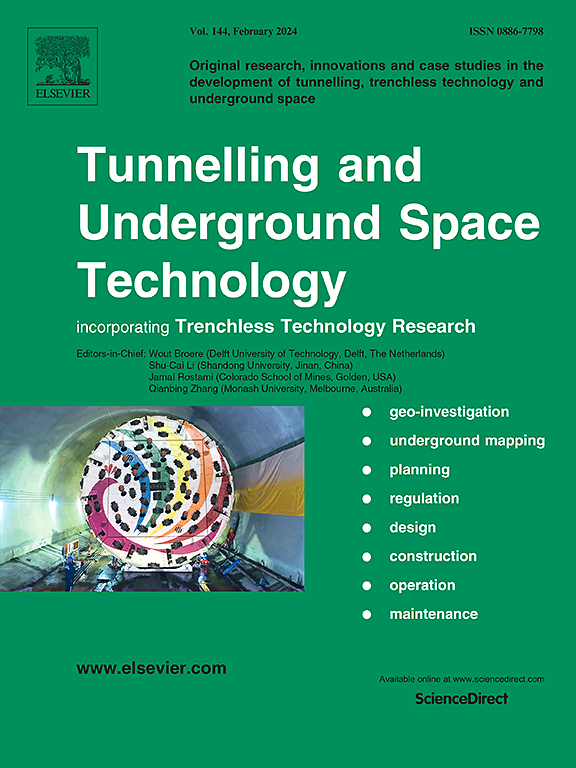不同侧压系数下排水系统对地下CAES储气库稳定性的影响
IF 7.4
1区 工程技术
Q1 CONSTRUCTION & BUILDING TECHNOLOGY
引用次数: 0
摘要
随着大规模物理储能需求的增加,内衬岩洞(LRC)已成为压缩空气储能(CAES)的理想解决方案。然而,排水系统作为LRC的一个重要组成部分,在以往的研究中往往被忽视。衬砌后的排水管道在高内循环压力作用下增加了混凝土衬砌的开裂潜力,可视为缺陷。本研究建立了由钢衬砌密封层、C30混凝土衬砌、C25混凝土喷淋层、排水系统、围岩组成的LRC综合模型。考虑排水系统参数(排水管间距1 m和2 m,排水管内径10 cm和15 cm)和侧压力系数(0.8、1.0、1.2),对LRC开挖和运行阶段进行了模拟。结果表明:开挖阶段排水系统影响较小,排水管道附近C25混凝土喷淋层应力集中,对围岩位移和钢衬砌应力影响不大;排水系统在运行阶段对LRC稳定性影响显著,C25混凝土喷淋层和C30混凝土衬砌出现大量应力集中和破坏,钢衬砌应力和围岩位移增加。侧压力系数为1.0或1.2时,LRC稳定性最佳,为0.8时稳定性最差。在最坏情况下,与不加排水系统的轻钢筋混凝土相比,轻钢筋混凝土最大衬钢应力增大29.89 MPa,围岩顶板位移增大1.46 mm。同时,排水管内径对洞室稳定性的影响大于排水管间距。这些发现表明,尽管排水系统的存在在传统隧道设计中可以忽略不计,但在CAES LRC的计算、设计和施工中必须仔细考虑其影响。本文章由计算机程序翻译,如有差异,请以英文原文为准。
Influence of drainage system on the stability of underground CAES gas storage under different lateral pressure coefficients
As demand for large-scale physical energy storage increases, lined rock caverns (LRC) have emerged as an ideal solution for compressed air energy storage (CAES). However, drainage systems, a crucial component of LRC, have often been overlooked in prior studies. Drainage pipes behind the lining can be considered as defects since they increase the cracking potential of the concrete lining when subject to high internal circulating pressure. In this study, a comprehensive LRC model is established, consisting of a steel lining sealing layer, C30 concrete lining, C25 concrete spray layer, drainage system, and surrounding rock. Both excavation and operation stages of LRC are simulated considering various drainage system parameters (drainage pipe spacing: 1 m and 2 m, drainage pipe inner diameter: 10 cm and 15 cm) and lateral pressure coefficients (0.8, 1.0, 1.2). Results show that the drainage system has minimal impact during the excavation phase, causing stress concentrations in the C25 concrete spray layer near the drainage pipes but little effect on the surrounding rock displacement or steel lining stress. In contrast, the drainage system affects LRC stability significantly in operational phase, inducing substantial stress concentrations and damage in the C25 concrete spray layer and C30 concrete lining, as well as an increase in steel lining stress and surrounding rock displacement. The stability of LRC is optimal when lateral pressure coefficient is 1.0 or 1.2, and worst when it is 0.8. In the worst scenario, the maximum steel lining stress in the LRC increases by 29.89 MPa and the displacement of the surrounding rock roof increases by 1.46 mm, compared to LRC without a drainage system. Meanwhile, the inner diameter of the drain pipe has a greater effect on the stability of the cavern than the spacing. These findings suggest that while the presence of a drainage system can be neglected in the design of conventional tunnels, its influence must be carefully considered in the calculation, design, and construction of LRC for CAES.
求助全文
通过发布文献求助,成功后即可免费获取论文全文。
去求助
来源期刊

Tunnelling and Underground Space Technology
工程技术-工程:土木
CiteScore
11.90
自引率
18.80%
发文量
454
审稿时长
10.8 months
期刊介绍:
Tunnelling and Underground Space Technology is an international journal which publishes authoritative articles encompassing the development of innovative uses of underground space and the results of high quality research into improved, more cost-effective techniques for the planning, geo-investigation, design, construction, operation and maintenance of underground and earth-sheltered structures. The journal provides an effective vehicle for the improved worldwide exchange of information on developments in underground technology - and the experience gained from its use - and is strongly committed to publishing papers on the interdisciplinary aspects of creating, planning, and regulating underground space.
 求助内容:
求助内容: 应助结果提醒方式:
应助结果提醒方式:


